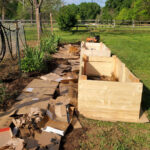
Raised Garden Beds
Raised garden beds are a great way to grow vegetables, herbs, potatoes and even flowers.
Servings 1 raised bed
Ingredients
Raised Beds
- 1 (4x4x8) pine lumber (not pressure treated)
- 3 (2x6x10) pine lumber (not pressure treated)
- 1 (2x6x12) pine lumber (not pressure treated)
- 2-3 pounds (#10) 3 ½-inch decking screws
- ½ pound (#10) 2 ½-inch decking screws
Instructions
Raised Garden Beds
- 2x6x10 pine boards will be cut once at 7 feet, leaving a 3-foot section to be used for the sides.
- 2x6x12 pine boards will be cut twice. One cut at 7 feet and another at 3 foot, leaving a 2 foot piece to be used as bracing in the center.
- Cut the 4x4 pine board into four sections, 2-feet each.
- The 7-foot pieces (2x6 boards) should be lined up to be flush with the ends of the 3-foot (2x6 boards). Predrill and countersink holes and use 3 ½-inch screws to secure boards together on all four corners.
- Measure the rectangle to make sure it is square. Then place 4x4 (2-foot) boards in each corner. Predrill and countersink holes and use 3 ½-inch screws to secure boards on all eight sides, contacting the 2x6 boards. (Approximately 3 screws per side)
- Continue placing 2x6 boards and fastening at each end in the same manner as the same boards, until all boards are fully secured.
- Take the 2x6 (2-foot boards) and place them vertically in the center of the 7-foot section, spanning all four 2x6 (7-foot boards) on each side. Predrill and countersink and use the 2 ½-inch screws to secure. (Approximately 2 screws per 7-foot long board)
Filling Raised Beds
- Choose the best placement for it in your yard. For many vegetables, they prefer full-sun. Choose the best location based on your needs.
- Cover the grass or area where you will place the raised bed with a layer of flattened cardboard. Remove any plastic packing tape, as it is not biodegradable.
- Add a layer of organic material, including sticks, branches, leaves, coffee grounds, paper coffee filters, eggshells and other natural products.
- Use a 50/50 mixture on top of the organic materials (50% topsoil and 50% compost). Use either your own compost or locally purchased from a garden or landscape supply store.
- You can use a bulk 50/50 raised bed mixture or bagged soil for raised beds. Use whatever is most convenient for you.
- Add your vegetable seeds and/or plants. Use plant markers to identify what you have planted.
- Water as needed.
Notes
These plans make one raised bed that is 3 feet x 7 feet long and 2 feet tall.
Placement of raised beds should be based on what you plan on growing. We opted for a full-sun location near our existing vegetable garden.
Do NOT add stones or rocks to the bottom of raised beds, as this will potentially cause an issue with drainage.